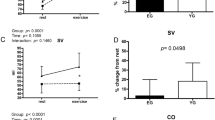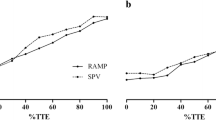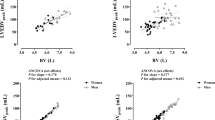Abstract
Background
Age-related differences concerning cardiorespiratory responses and myocardial function during exercise have not been extensively investigated in healthy populations.
Aims
To compare cardiorespiratory performance and myocardial function during maximal exercise in healthy/unmedicated men (older, n = 24, 63–75 years; young, n = 22, 19–25 years) and women (older, n = 18, age = 63–74 years; young, n = 23, 19–25 years).
Methods
Oxygen uptake (VO2), ventilation minute (V E), heart rate (HR), stroke volume (SV), cardiac output (Q), O2 pulse (O2p), preejection period (PEP), and left ventricular ejection time (LVET) were assessed during cycle incremental exercise.
Results
HR and SV remained equivalent between age groups until 75 and 50% peak workload, respectively. Q increased by 2.5 and 4.5 times in older and young groups, respectively. However, Q/VO2 ratio was always similar across age and sex groups (∼0.50). The energetic efficiency ratio (W/VO2) was also alike in older and young men, but slightly lower in women. At maximal exercise, cardiorespiratory responses were lower in older than young men and women: VO2 (−40 to 50%), V E (−35 to 37%), HR (−23%), SV (−26 to 29%), Q (−43 to 45%), and O2p (−15 to 20%). Cardiac and SV indices were lower in older than young groups by approximately 42 and 25%, respectively. LVET was longer in the older individuals, while PEP was similar across age groups. Hence, PEP/LVET was lowered among older vs. young men and women.
Conclusion
Submaximal work capacity was preserved in healthy and unmedicated older individuals. Age-related lessening of maximal performance in both sexes was due to poor chronotropic and, particularly, inotropic properties of the heart.


Similar content being viewed by others
References
Rodeheffer RJ, Gerstenblith G, Becker LC et al (1984) Exercise cardiac output is maintained with advancing age in healthy human subjects: cardiac dilatation and increased stroke volume compensate for a diminished heart rate. Circulation 69:203–213
Wiebe CG, Gledhill N, Jamnik VK et al (1999) Exercise cardiac function in young through elderly endurance trained women. Med Sci Sports Exerc 31:684–691
Vigorito C, Giallauria F (2014) Effects of exercise on cardiovascular performance in the elderly. Front Physiol 5:51. doi:10.3389/fphys.2014.00051
Hossack KF, Bruce RA (1982) Maximal cardiac function in sedentary normal men and women: comparison of age-related changes. J Appl Physiol Respir Environ Exerc Physiol 53:799–804
McElvaney GN, Blackie SP, Morrison NJ et al (1989) Cardiac output at rest and in exercise in elderly subjects. Med Sci Sports Exerc 21:293–298
Krzeminski K, Niewiadomski W, Nazar K (1989) Dynamics of changes in the cardiovascular response to submaximal exercise during low-intensity endurance training with particular reference to the systolic time intervals. Eur J Appl Physiol Occup Physiol 59:377–384
Reant P, Dijos M, Donal E et al (2010) Systolic time intervals as simple echocardiographic parameters of left ventricular systolic performance: correlation with ejection fraction and longitudinal two-dimensional strain. Eur J Echocardiogr 11:834–844. doi:10.1093/ejechocard/jeq084
Garrard CL Jr, Weissler AM, Dodge HT (1970) The relationship of alterations in systolic time intervals to ejection fraction in patients with cardiac disease. Circulation 42:455–462
Klabunde RE (2011) Cardiovascular physiology concepts. 2nd edn. Lippincott Williams & Wilkins, Philadelphia
Boudoulas H (1990) Systolic time intervals. Eur Heart J 11:93–104
Astrand PO, Bergh U, Kilbom A (1997) A 33-year follow-up of peak oxygen uptake and related variables of former physical education students. J Appl Physiol (1985) 82:1844–1852
Fleg JL, Morrell CH, Bos AG et al (2005) Accelerated longitudinal decline of aerobic capacity in healthy older adults. Circulation 112:674–682. doi:10.1161/CIRCULATIONAHA.105.545459
Proctor DN, Beck KC, Shen PH et al (1998) Influence of age and gender on cardiac output-VO2 relationships during submaximal cycle ergometry. J Appl Physiol (1985) 84:599–605
Christou DD, Seals DR (2008) Decreased maximal heart rate with aging is related to reduced {beta}-adrenergic responsiveness but is largely explained by a reduction in intrinsic heart rate. J Appl Physiol (1985) 105:24–29. doi:10.1152/japplphysiol.90401.2008
Farinatti PT, Soares PP (2009) Cardiac output and oxygen uptake relationship during physical effort in men and women over 60 years old. Eur J Appl Physiol 107:625–631. doi:10.1007/s00421-009-1162-y
Vella CA, Robergs RA (2005) A review of the stroke volume response to upright exercise in healthy subjects. Br J Sports Med 39:190–195. doi:10.1136/bjsm.2004.013037
Crisafulli A, Piras F, Chiappori P et al (2007) Estimating stroke volume from oxygen pulse during exercise. Physiol Meas 28:1201–1212. doi:10.1088/0967-3334/28/10/006
Ogawa T, Spina RJ, Martin WH 3rd et al (1992) Effects of aging, sex, and physical training on cardiovascular responses to exercise. Circulation 86:494–503
Fleg JL, O’Connor F, Gerstenblith G et al (1995) Impact of age on the cardiovascular response to dynamic upright exercise in healthy men and women. J Appl Physiol (1985) 78:890–900
Fukuta H, Little WC (2007) Contribution of systolic and diastolic abnormalities to heart failure with a normal and a reduced ejection fraction. Prog Cardiovasc Dis 49:229–240. doi:10.1016/j.pcad.2006.08.009
Fournier SB, Reger BL, Donley DA et al (2014) Exercise reveals impairments in left ventricular systolic function in patients with metabolic syndrome. Exp Physiol 99:149–163. doi:10.1113/expphysiol.2013.075796
Higginbotham MB, Morris KG, Williams RS et al (1986) Physiologic basis for the age-related decline in aerobic work capacity. Am J Cardiol 57:1374–1379
Bogaard HJ, Woltjer HH, Dekker BM et al (1997) Haemodynamic response to exercise in healthy young and elderly subjects. Eur J Appl Physiol Occup Physiol 75:435–442. doi:10.1007/s004210050185
Herdy AH, Uhlendorf D (2010) Reference values for cardiopulmonary exercise testing for sedentary and active men and women. Arq Bras Cardiol 96:54–59
Wajngarten M, Negrão CE, Kalil LMP et al (1994) Influence of aging and exercise training on the increase in oxygen uptake as a function of the increase in work rate. Cardiol Elder 2:421–426
Gerstenblith G, Renlund DG, Lakatta EG (1987) Cardiovascular response to exercise in younger and older men. Fed Proc 46:1834–1839
Lakatta EG, Levy D (2003) Arterial and cardiac aging: major shareholders in cardiovascular disease enterprises: Part II: the aging heart in health: links to heart disease. Circulation 107:346–354
Hees PS, Fleg JL, Mirza ZA et al (2006) Effects of normal aging on left ventricular lusitropic, inotropic, and chronotropic responses to dobutamine. J Am Coll Cardiol 47:1440–1447. doi:10.1016/j.jacc.2005.11.052
Yamada K, Isobe S, Hirai M et al (2006) Changes with age in left ventricular function and volumes at rest and postexercise in postmenopausal women. Ann Nucl Med 20:677–681
Arbab-Zadeh A, Dijk E, Prasad A et al (2004) Effect of aging and physical activity on left ventricular compliance. Circulation 110:1799–1805. doi:10.1161/01.CIR.0000142863.71285.74
Milia R, Roberto S, Mulliri G et al (2015) Effect of aging on hemodynamic response to metaboreflex activation. Eur J Appl Physiol 115:1693–1703. doi:10.1007/s00421-015-3153-5
Lewis RP, Rittogers SE, Froester WF et al (1977) A critical review of the systolic time intervals. Circulation 56:146–158
Crisafulli A, Melis F, Orrù V et al (2001) Impedance cardiography for non invasive assessment of systolic time intervals during exercise. Sports Med Train Rehabil 10:13–27
Sheps DS, Petrovick ML, Kizakevich PN et al (1982) Continuous noninvasive monitoring of left ventricular function during exercise by thoracic impedance cardiography-automated derivation of systolic time intervals. Am Heart J 103:519–524
Miyamoto Y, Higuchi J, Abe Y et al (1983) Dynamics of cardiac output and systolic time intervals in supine and upright exercise. J Appl Physiol Respir Environ Exerc Physiol 55:1674–1681
Port S, Cobb FR, Coleman RE et al (1980) Effect of age on the response of the left ventricular ejection fraction to exercise. N Engl J Med 303:1133–1137. doi:10.1056/NEJM198011133032001
Acknowledgements
We thank Dr. Jacques H.P. Vanfraechem from the Free University of Brussels for the precious support during data collection and analysis. This study was supported by grants from the ‘Carlos Chagas Foundation for the Research Support at the State of Rio de Janeiro’ (FAPERJ) and ‘Brazilian Council for Technological and Research Development’ (CNPq).
Author information
Authors and Affiliations
Corresponding author
Ethics declarations
Conflict of interest
On behalf of all authors, the corresponding author states that there is no conflict of interest.
Human and animal rights
All procedures performed in studies involving human participants were in accordance with the ethical standards of the institutional and/or national research committee and with the 1964 Helsinki declaration and its later amendments or comparable ethical standards. This article does not contain any studies with animals performed by any of the authors.
Informed consent
Informed consent was obtained from all individual participants included in the study.
Rights and permissions
About this article
Cite this article
Farinatti, P., Monteiro, W., Oliveira, R. et al. Cardiorespiratory responses and myocardial function within incremental exercise in healthy unmedicated older vs. young men and women. Aging Clin Exp Res 30, 341–349 (2018). https://doi.org/10.1007/s40520-017-0776-x
Received:
Accepted:
Published:
Issue Date:
DOI: https://doi.org/10.1007/s40520-017-0776-x




